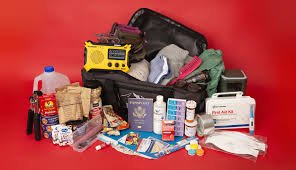Whether you’re hiking through the Himalayas, camping in the Amazon, or navigating a foreign city, one thing is certain: emergencies can happen anytime, anywhere. While travel is all about adventure, preparation is the key to peace of mind. That’s where emergency survival kits come in.
From power outages and lost luggage to unexpected weather or medical needs, having a well-thought-out survival kit can mean the difference between inconvenience and a real crisis. In this blog, we explore the top emergency survival kits every traveler should carry—because smart travel is safe travel.
🧳 What Is a Travel Emergency Survival Kit?
A travel emergency survival kit is a portable collection of essential items that can help you handle unexpected situations while on the road. These kits can be pre-packaged or self-assembled and usually include first aid, food, water, tools, and tech essentials.
While hardcore survival kits are designed for the wilderness or disaster response, travel-specific kits focus on the needs of modern adventurers: health, navigation, communication, and safety.
🧭 1. Basic All-Purpose Travel Survival Kit
Best For: Urban and casual travelers, business trips, city tours
This kit is compact and easy to fit in your carry-on. It’s designed for common travel hiccups like getting lost, losing power, or dealing with a minor injury.
What to Include:
-
Compact first-aid kit (band-aids, antiseptic wipes, tweezers, pain relievers)
-
Flashlight or mini LED torch
-
Multi-tool (with knife, scissors, screwdriver)
-
Travel sewing kit
-
Duct tape (mini roll)
-
Emergency contact list (paper + digital)
-
Whistle for attention-grabbing
Pro Tip: Store everything in a waterproof pouch or organizer to keep it dry and easy to find.
🚑 2. First Aid Survival Kit for Travelers
Best For: Families, solo travelers, backpackers
A solid first-aid kit is non-negotiable. Whether it’s a scraped knee or food poisoning, quick access to medical supplies can be a lifesaver.
What to Include:
-
Sterile bandages, gauze, and medical tape
-
Antiseptic cream, hand sanitizer, and alcohol pads
-
Anti-diarrheal pills and rehydration salts
-
Antihistamines for allergies
-
Motion sickness pills
-
Tweezers, scissors, and thermometer
-
Gloves and face masks
-
Any personal medications (with doctor’s note)
Pro Tip: If traveling internationally, include a multilingual medical information card with allergies, blood type, and emergency contacts.
🔋 3. Tech Emergency Kit
Best For: Digital nomads, vloggers, remote workers
In today’s world, your phone or laptop isn’t just a gadget—it’s your lifeline. A tech emergency kit ensures you stay connected, informed, and powered up.
What to Include:
-
Power bank (minimum 10,000 mAh)
-
Universal travel adapter with surge protection
-
Backup charging cables (USB-C, micro-USB, Lightning)
-
Portable Wi-Fi hotspot or global SIM
-
Emergency flashlight with USB charging
-
SD card or USB stick for backups
-
Offline maps app (like Maps.me or Gaia GPS)
Pro Tip: Label cords and gadgets with colored tape or tags for easy identification when in a rush.
🏕️ 4. Outdoor & Adventure Survival Kit
Best For: Hikers, campers, remote travelers
Heading off-grid? This kit prepares you for the wild—where self-reliance matters most.
What to Include:
-
Firestarter (matches, flint, or waterproof lighter)
-
Emergency thermal blanket
-
Compact water filter or purification tablets
-
Collapsible water bottle
-
Signal mirror and whistle
-
Paracord (can be used for shelter, repairs, etc.)
-
Emergency food rations or energy bars
-
Folding knife or multitool
Pro Tip: Go for ultra-light gear designed for backpacking to keep your pack light but complete.
🌧️ 5. Weather-Ready Survival Kit
Best For: All travelers during uncertain weather or disaster-prone areas
Storms, floods, or sudden weather shifts can be dangerous, especially in unfamiliar territory. This kit will help you stay dry, warm, and protected.
What to Include:
-
Waterproof poncho
-
Extra socks and compact dry clothes
-
Windproof lighter
-
Thermal hand warmers
-
Waterproof phone case
-
Laminated emergency contacts and ID
-
Pocket-sized weather radio (battery or hand crank)
Pro Tip: Keep an emergency cash stash in small local currency in this kit.
🛬 6. Airport and Transit Survival Kit
Best For: Long-haul fliers, connecting flights, or unexpected delays
Missed connections and delayed luggage are common, so be ready to wait it out in comfort.
What to Include:
-
Earplugs and eye mask
-
Portable charger and plug adapter
-
Snacks (protein bars, nuts)
-
Toiletries (toothbrush, wipes, deodorant)
-
Travel pillow
-
Important documents (passport copy, insurance, visa)
-
Extra pair of underwear or socks
Pro Tip: Pack this kit in your personal item (not your checked bag!) so it’s always with you.
🧠 Extra Smart Travel Survival Hacks
-
Keep duplicates of key items like chargers and documents in separate bags.
-
Use ziplock bags to group related items (meds, electronics, food).
-
Regularly check and update kits before each trip—medications and batteries expire!
-
Customize based on destination—mountain gear for trekking, hydration gear for desert, etc.
-
Download emergency numbers for the local area or country before arrival.
📦 Top Pre-Made Survival Kits for Travelers (2025 Picks)
If you don’t want to build your own kit from scratch, here are some top-rated ready-made options:
🧰 1. VSSL Travel Emergency Kit
A sleek, waterproof tube packed with essentials for minor injuries, survival, and navigation. TSA-friendly.
🧳 2. LifeStraw Go Kit
Includes a filtration water bottle, first aid supplies, and flashlight. Perfect for hiking and international travel.
🧰 3. MyMedic Solo First Aid Kit
Small but powerful, this pouch contains everything needed for minor to serious injuries. Great for road trips and outdoor travel.
✈️ Final Thoughts
You don’t have to be a survivalist to be prepared. In fact, smart travelers know that packing a reliable emergency kit is just as important as choosing the right destination. Whether you’re headed to a bustling city, a remote village, or somewhere in between, having the right survival tools gives you freedom, flexibility, and confidence.
The key is simple: hope for the best, prepare for the worst, and travel smart.

